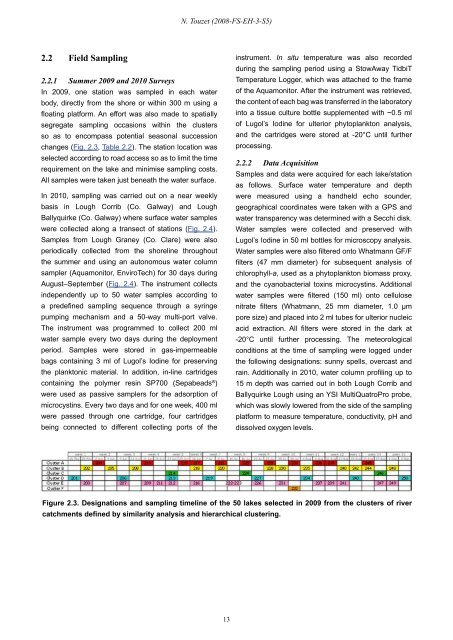STRIVE - Environmental Protection Agency
STRIVE - Environmental Protection Agency
STRIVE - Environmental Protection Agency
You also want an ePaper? Increase the reach of your titles
YUMPU automatically turns print PDFs into web optimized ePapers that Google loves.
2.2 Field Sampling<br />
2.2.1 Summer 2009 and 2010 Surveys<br />
In 2009, one station was sampled in each water<br />
body, directly from the shore or within 300 m using a<br />
floating platform. An effort was also made to spatially<br />
segregate sampling occasions within the clusters<br />
so as to encompass potential seasonal succession<br />
changes (Fig. 2.3, Table 2.2). The station location was<br />
selected according to road access so as to limit the time<br />
requirement on the lake and minimise sampling costs.<br />
All samples were taken just beneath the water surface.<br />
In 2010, sampling was carried out on a near weekly<br />
basis in Lough Corrib (Co. Galway) and Lough<br />
Ballyquirke (Co. Galway) where surface water samples<br />
were collected along a transect of stations (Fig. 2.4).<br />
Samples from Lough Graney (Co. Clare) were also<br />
periodically collected from the shoreline throughout<br />
the summer and using an autonomous water column<br />
sampler (Aquamonitor, EnviroTech) for 30 days during<br />
August–September (Fig. 2.4). The instrument collects<br />
independently up to 50 water samples according to<br />
a predefined sampling sequence through a syringe<br />
pumping mechanism and a 50-way multi-port valve.<br />
The instrument was programmed to collect 200 ml<br />
water sample every two days during the deployment<br />
period. Samples were stored in gas-impermeable<br />
bags containing 3 ml of Lugol’s Iodine for preserving<br />
the planktonic material. In addition, in-line cartridges<br />
containing the polymer resin SP700 (Sepabeads ® )<br />
were used as passive samplers for the adsorption of<br />
microcystins. Every two days and for one week, 400 ml<br />
were passed through one cartridge, four cartridges<br />
being connected to different collecting ports of the<br />
N. Touzet (2008-FS-EH-3-S5)<br />
13<br />
instrument. In situ temperature was also recorded<br />
during the sampling period using a StowAway TidbiT<br />
Temperature Logger, which was attached to the frame<br />
of the Aquamonitor. After the instrument was retrieved,<br />
the content of each bag was transferred in the laboratory<br />
into a tissue culture bottle supplemented with ~0.5 ml<br />
of Lugol’s Iodine for ulterior phytoplankton analysis,<br />
and the cartridges were stored at -20°C until further<br />
processing.<br />
2.2.2 Data Acquisition<br />
Samples and data were acquired for each lake/station<br />
as follows. Surface water temperature and depth<br />
were measured using a handheld echo sounder,<br />
geographical coordinates were taken with a GPS and<br />
water transparency was determined with a Secchi disk.<br />
Water samples were collected and preserved with<br />
Lugol’s Iodine in 50 ml bottles for microscopy analysis.<br />
Water samples were also filtered onto Whatmann GF/F<br />
filters (47 mm diameter) for subsequent analysis of<br />
chlorophyll-a, used as a phytoplankton biomass proxy,<br />
and the cyanobacterial toxins microcystins. Additional<br />
water samples were filtered (150 ml) onto cellulose<br />
nitrate filters (Whatmann, 25 mm diameter, 1.0 µm<br />
pore size) and placed into 2 ml tubes for ulterior nucleic<br />
acid extraction. All filters were stored in the dark at<br />
-20°C until further processing. The meteorological<br />
conditions at the time of sampling were logged under<br />
the following designations: sunny spells, overcast and<br />
rain. Additionally in 2010, water column profiling up to<br />
15 m depth was carried out in both Lough Corrib and<br />
Ballyquirke Lough using an YSI MultiQuatroPro probe,<br />
which was slowly lowered from the side of the sampling<br />
platform to measure temperature, conductivity, pH and<br />
dissolved oxygen levels.<br />
Figure 2.3. Designations and sampling timeline of the 50 lakes selected in 2009 from the clusters of river<br />
catchments defined by similarity analysis and hierarchical clustering.

















